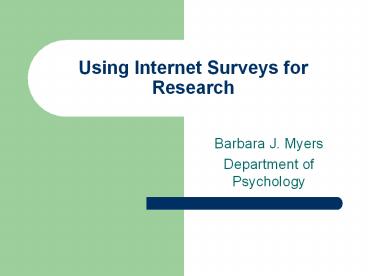Using Internet Surveys for Research - PowerPoint PPT Presentation
1 / 15
Title: Using Internet Surveys for Research
1
Using Internet Surveys for Research
- Barbara J. Myers
- Department of Psychology
2
Why do we use Internet surveys?
- Rare populations
- Hard-to-find populations
- Populations that cannot come to you
3
Why do we use Internet surveys?
- Convenient for participants
- Low-costNo paper, no postage
- Data entry is automatic
4
Other researchers could target participants . . .
- When you have their e-mailssend the announcement
straight to them - Participants who do not show up for appointments
to take surveys - Participants who are on the internet in the
middle of the night
5
Our 3 studies using internet surveys
- Parents of children with autism (N 520)
- Parents of children with either autism (n
212) or Down syndrome (n 68) - Parents from India, now living outside India,
with children with autism (n 27)
6
Recruitment of our samples
- E-mail contact with organizations that these
parents use - Autism Society of America
- Every state, county, city chapter
- Asked them to place a notice in their newsletters
or link on their webpage - Over 220 organizations contacted
7
Creating the questionnaires
- Inquisite program
- Get the CD and install it on your computer
- Inquisite walks you through formatting of survey
8
Our questions
- Button-type answers
- Short-answer fill-in (e.g., other medications not
already listed?) - Some questions branched
- Open-ended questions had room for essay-length
qualitative answers - We asked TONS of questions
9
Explaining purpose of study to participants
- Entry page stated purpose of the survey
- Told them who we were, our contact info
- That this was research
- Estimated time to take survey
- That they were free to not take part
- That submitting their answers constituted
granting CONSENT to be in study
10
Protecting confidentiality
- We collected no identifying information
- No names, addresses, birthdates, emails
- No information on where they saw notice about
study - We dont know who they are and will never contact
them again
11
Accessing our data
- First stored in Inquisite file, with password
protection - Inquisite transforms data to SPSS or ACCESS
- Stored these datasets on office computers
- (Inquisite writes little reports that are useless)
12
Do we get publishable research?
- Data from 1st study7 papers published or in
press - Goin-Kochel, R.P., Mackintosh, V.H., Myers,
B.J. (in pressaccepted 11-24-2008). Parental
reports on the efficacy of treatments and
therapies for their children with autism spectrum
disorders. Research in Autism Spectrum Disorders. - Myers, B.J., Mackintosh, V.H., Goin-Kochel,
R.P. (in pressaccepted 09-09-2008). My greatest
joy and my greatest heart ache Parents own
words on how having a child in the autism
spectrum has affected their lives and their
families lives. Research in Autism Spectrum
Disorders. - Goin-Kochel, R. P., Mackintosh, V.H., Myers,
B.J. (2007). Parental reports on the use of
treatments and therapies for children with autism
spectrum disorders. Research in Autism Spectrum
Disorders, 1, 195-209. - Mackintosh, V.H., Goin-Kochel, R.P., Myers,
B.J. (2006). Sources of Information and Support
Used by Parents of Children with Autism Spectrum
Disorders. Journal on Developmental Disabilities,
12 (1), 41-51. - Goin-Kochel, R.P., Mackintosh, V.H., Myers,
B.J. (2006). How Many Doctors Does It Take to
Make an Autism-Spectrum Diagnosis? Autism, 10
(5), 439-451. - Goin-Kochel, R.P. Myers, B.J. (2005). The
congenital vs. regressive onset of autism and
parents beliefs about causes. Focus on Autism
and Other Developmental Disabilities, 20 (3),
169-179. - Goin-Kochel, R.P. Myers, B.J. (2005). Parental
report of early autistic symptoms Differences in
ages of detection and frequencies of
characteristics among three autism-spectrum
disorders. Journal on Developmental Disabilities,
11(2), 21-39. - Other two studiesmanuscripts in progress
13
Budget for these 3 studies?
- Zero
- Zero
- Zero
14
Drawbacks
- Sample is limited to people who own computers and
use internet - Fewer participants of low income
- Fewer minority families
- Fewer participants with low education
- Potential for junk responses
15
Advantages of internet surveys
- Ability to locate rare populations
- Ease of data collectionautomatic
- Convenient for participants
- Ability to collect an abundance of data
- Scientific journals publish the work
- Low budget, no budget, sustainable research































